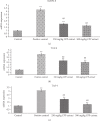Effect of Caesalpinia bonduc Polyphenol Extract on Alloxan-Induced Diabetic Rats in Attenuating Hyperglycemia by Upregulating Insulin Secretion and Inhibiting JNK Signaling Pathway
- PMID: 32256963
- PMCID: PMC7103044
- DOI: 10.1155/2020/9020219
Effect of Caesalpinia bonduc Polyphenol Extract on Alloxan-Induced Diabetic Rats in Attenuating Hyperglycemia by Upregulating Insulin Secretion and Inhibiting JNK Signaling Pathway
Abstract
Caesalpinia bonduc has been used in herbal medicines for the treatment of a wide range of diseases from decades. The present study has explored the remedial potential and underlying mechanism of polyphenol extract of Caesalpinia bonduc in alloxanized diabetic rats. HPLC/MS analysis confirmed the presence of phenolics in considerable concentrations in Caesalpinia bonduc extract. Administration of different doses (250 and 500 mg/kg) of CPP extract to hyperglycemic rats for 8 weeks restored blood and serum glucose, insulin, glycosylated hemoglobin, leptin, amylin, and carbohydrate metabolizing enzymes level towards normal compared to alloxanized diabetic group. The effect of CPP extract on various genes such as Pdx-1, Ins-1, ngn-3, GLUT-4, and IRS-1 in insulin signaling pathway and Traf-4, Traf-6, and Mapk-8 in MAPK downstream JNK cascade was examined through qRT-PCR to access the core molecular mechanism involved in CPP-induced recovery of diabetes. Results have revealed that CPP extract reduced oxidative stress in pancreatic β cells by restoring free radical scavenging potential, reducing the mRNA expression of Mapk-8, Traf-4, and Traf-6, and increasing the Pdx-1, Ins-1, ngn-3, GLUT-4, and IRS-1 expression ensuing regeneration of β cells and subsequent insulin release from pancreas. The results obtained in this study recommend that CPP extract may be a promising therapeutic restorative agent in the treatment of diabetes mellitus.
Copyright © 2020 Asra Iftikhar et al.
Conflict of interest statement
The authors declare no conflict of interest.
Figures





Similar articles
-
Anti-obesity and Anti-diabetic Effect of Ursolic Acid against Streptozotocin/High Fat Induced Obese in Diabetic Rats.J Oleo Sci. 2022 Feb 3;71(2):289-300. doi: 10.5650/jos.ess21258. Epub 2022 Jan 14. J Oleo Sci. 2022. PMID: 35034940
-
Synergistic Antioxidant and Antidiabetic Effects of Caesalpinia bonduc (L.) and Gymnema sylvestre (Retz.) in Alloxan-Induced Diabetic Rats.Chem Biodivers. 2025 May 12:e202500410. doi: 10.1002/cbdv.202500410. Online ahead of print. Chem Biodivers. 2025. PMID: 40354793
-
Polyherbal extract improves glycometabolic control in alloxan-induced diabetic rats via down-regulating the MAPK/JNK pathway, modulating Nrf-2/Keap-1 expression, and stimulating insulin signaling.Iran J Basic Med Sci. 2024;27(2):170-179. doi: 10.22038/IJBMS.2023.72553.15780. Iran J Basic Med Sci. 2024. PMID: 38234664 Free PMC article.
-
Comprehensive review of animal models in diabetes research using chemical agents.Lab Anim. 2025 Jun;59(3):356-363. doi: 10.1177/00236772241296199. Epub 2025 Jan 16. Lab Anim. 2025. PMID: 39817399 Review.
-
Experimental animal models for diabetes and its related complications-a review.Lab Anim Res. 2021 Aug 24;37(1):23. doi: 10.1186/s42826-021-00101-4. Lab Anim Res. 2021. PMID: 34429169 Free PMC article. Review.
Cited by
-
Phenolics Extracted from Jasminum sambac Mitigates Diabetic Cardiomyopathy by Modulating Oxidative Stress, Apoptotic Mediators and the Nfr-2/HO-1 Pathway in Alloxan-Induced Diabetic Rats.Molecules. 2023 Jul 17;28(14):5453. doi: 10.3390/molecules28145453. Molecules. 2023. PMID: 37513325 Free PMC article.
-
Pharmacological Properties of Polyphenols: Bioavailability, Mechanisms of Action, and Biological Effects in In Vitro Studies, Animal Models, and Humans.Biomedicines. 2021 Aug 23;9(8):1074. doi: 10.3390/biomedicines9081074. Biomedicines. 2021. PMID: 34440278 Free PMC article. Review.
-
Early myocardial injury biomarkers in diabetic hyperlipidemic rats: Impact of 10-dehydrogingerdione and vitamin D3.Exp Biol Med (Maywood). 2020 Sep;245(15):1326-1334. doi: 10.1177/1535370220943124. Epub 2020 Jul 19. Exp Biol Med (Maywood). 2020. PMID: 32686474 Free PMC article.
-
Mechanisms Underlying the Antidiabetic Activities of Polyphenolic Compounds: A Review.Front Pharmacol. 2021 Dec 14;12:798329. doi: 10.3389/fphar.2021.798329. eCollection 2021. Front Pharmacol. 2021. PMID: 34970150 Free PMC article. Review.
-
High anti-inflammatory and antidiabetic activities of Hammada elegans (Bge.)Botsch (Chenopodiaceae) extracts: an in vivo assessment.J Diabetes Metab Disord. 2021 Feb 13;20(1):427-438. doi: 10.1007/s40200-021-00762-x. eCollection 2021 Jun. J Diabetes Metab Disord. 2021. PMID: 34178849 Free PMC article.
References
-
- Alsharidah M., Algeffari M., Abdel-Moneim A. M. H., Lutfi M. F., Alshelowi H. Effect of combined gliclazide/metformin treatment on oxidative stress, lipid profile, and hepatorenal functions in type 2 diabetic patients. Saudi Pharmaceutical Journal. 2018;26(1):1–6. doi: 10.1016/j.jsps.2017.11.007. - DOI - PMC - PubMed
MeSH terms
Substances
LinkOut - more resources
Full Text Sources
Medical
Research Materials
Miscellaneous

